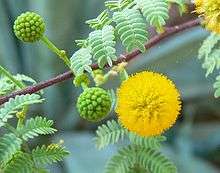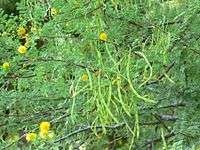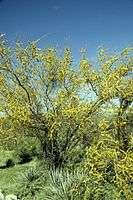Vachellia constricta
| Vachellia constricta | |
|---|---|
 | |
| Scientific classification | |
| Kingdom: | Plantae |
| (unranked): | Angiosperms |
| (unranked): | Eudicots |
| (unranked): | Rosids |
| Order: | Fabales |
| Family: | Fabaceae |
| Genus: | Vachellia |
| Species: | V. constricta |
| Binomial name | |
| Vachellia constricta (Benth.) Seigler & Ebinger[1] | |
| Synonyms | |
|
Acacia constricta Benth. | |
Vachellia constricta, also known commonly as the whitethorn acacia, is a shrub native to Mexico and the Southwestern United States, with a disjunct eastern population in Virginia and Maryland.[2][3]
Distribution
In the Southwest V. constricta grows in the southern half of Arizona, extending into New Mexico and West Texas. It grows in Mexico as far south as Oaxaca, with small disjunct populations in Baja California and in the Magdalena Plain of Baja California Sur.
In the Sonoran Desert, Vachellia constricta grows in arroyos and washes, where it blooms in late spring (April–May), with a second round of blooms in July–October. Blooming requires a minimum amount of rain, followed by a period of warmth.
Description
Vachellia constricta typically grows to 2 metres (6.6 ft) in height, occasionally reaching 6 metres (20 ft). Its stems range from a light gray to a mahogany color, with pairs of straight white spines anywhere from 0.5 to 2 cm long.
The small leaves are even-pinnate, usually 2.5–4 cm in length, with each of the 3-9 pairs of pinnae made of 4-16 pairs of leaflets, which are about 3.5 mm long and 1 mm wide. The flowers occur in small yellow balls about 1 cm in diameter. The flowers offer no nectar and little pollen, and so tend to have few visitors. Extrafloral nectaries grow along the main stem of the compound leaves and attract ants to the trees. The seed pods are relatively long and thin, up to 12 cm long but only 3–6 mm wide.
The leaves may drop in response to either dryness or cold.
 Vachellia constricta seed pods
Vachellia constricta seed pods Vachellia constricta tree.
Vachellia constricta tree.
Cultivation
Vachellia constricta is cultivated by specialty plant nurseries as an ornamental plant. It is used in native plant desert habitat gardens. It can be trained as a small tree or grown as a barrier hedges.
References
- ↑ Seigler DS, Ebinger JE. (2005). "New combinations in the genus Vachellia (Fabaceae: Mimosoideae) from the New World.". Phytologia. 87 (3): 139–78.
- ↑ USDA
- ↑ USDA FEIS data
General references
- Raymond M. Turner, Janice E. Bowers, and Tony L. Burgess, Sonoran Desert Plants: an Ecological Atlas (Tucson: The University of Arizona Press, 1995) pp. 15–16
External links
| Wikimedia Commons has media related to Vachellia constricta. |
- USDA Plants profile: Vachellia constricta (as Acacia constricta)
- USFS: Vachellia constricta (as Acacia constricta)
- Lady Bird Johnson Wildflower Center